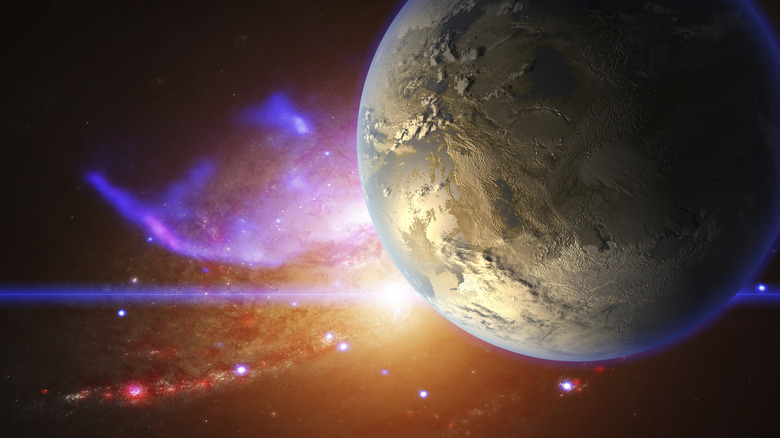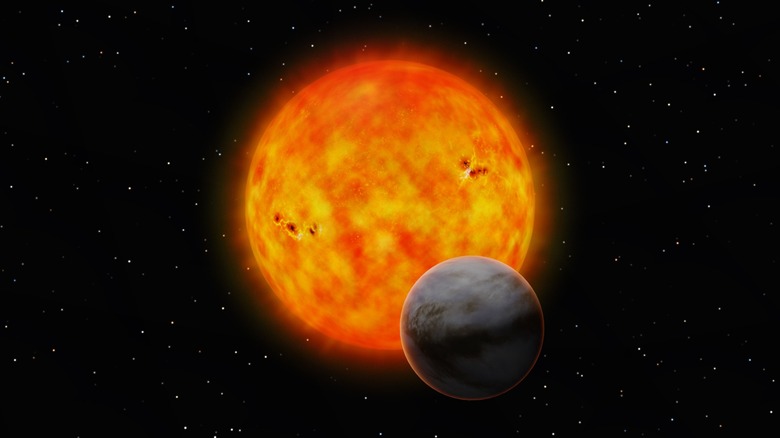NASA Is Tracking A Rare Planet Unlike Anything In Our Solar System
While scientists continue to find out new things about the celestial objects in our own solar system, they also monitor astronomical bodies that exist beyond. Case in point: Astronomers have been watching the GJ 1214 b exoplanet since 2009, and recent studies indicate that it isn't what they thought. In fact, it might be a new type of planet for which there's no classification yet.
Named Enaiposha in 2023, the exoplanet is just 48 light-years away, so it's relatively easy to see with the James Webb Space Telescope (JWST), which captured a baffling object around our stellar neighbor Vega in 2024. Scientists initially believed that it was a mini-Neptune or super-Earth because of its thick atmosphere, which is common among those planets. Plus, these are the main types of exoplanets they've discovered in the Milky Way so far. However, an international team of researchers led by Kazumasa Ohno, from the National Astronomical Observatory of Japan, and Everett Schlawin, from the University of Arizona and Steward Observatory, believe differently.
Observational data from the JWST, published in The Astrophysical Journal Letters, revealed that Enaiposha possibly has a dense carbon dioxide atmosphere, but Ohno explained in a statement, "The detected CO2 signal from the first study is tiny, and so it required careful statistical analysis to ensure that it is real. At the same time, we needed the physical and chemical insights to extract the true nature of GJ 1214 b's atmosphere from Schlawin's study." That's when Ohno and his team started using theoretical models to run various scenarios. The results, published in The Astrophysical Journal Letters, consistently suggested that the exoplanet's atmosphere has very little hydrogen and is, instead, dominated by metals. If follow-up studies confirm this, Enaiposha could be classified as a super-Venus, a new type of celestial body.
How would a super-Venus differ from a mini-Neptune or super-Earth?
Like the characteristics of the eight planets, the characteristics of a super-Venus and either a super-Earth or mini-Neptune are quite different. For starters, our sister planet Venus has a dense atmosphere made mostly of carbon dioxide and thick sulfuric acid clouds, which is why we don't know much about its surface yet. The planet is also 0.72 astronomical units from the sun — a type of measurement for measuring distance in outer space. If the new data about GJ 1214 b is confirmed and the classification of "super-Venus" sticks, it would be a reference for exoplanets that have similar atmospheres and proximities to their stars but are much bigger in size. It would be fitting for the exoplanet Enaiposha, which is also super hot because of its proximity to its star — just 0.0149 astronomical units away.
The characteristics of a super-Earth or mini-Neptune, on the other hand, are practically opposite. For example, a super-Earth is a reference to an exoplanet that is up to 10 times as big as Earth but smaller and lighter than Neptune. A mini-Neptune is a reference to an exoplanet that reaches or exceeds the upper limits of a super-Earth. In either case, the label doesn't necessarily mean that the atmosphere is similar to the comparable planet. Instead, these types of exoplanets can be mostly made of gas, ice, or water, and they can be so hot that metal would vaporize. Scientists have found more than 5,800 exoplanets so far, and they continue to study them in the hopes of discovering signs of life off Earth and understanding better how planetary systems form and evolve.

